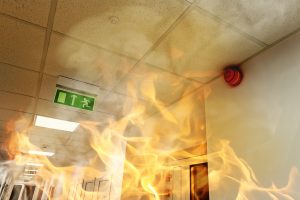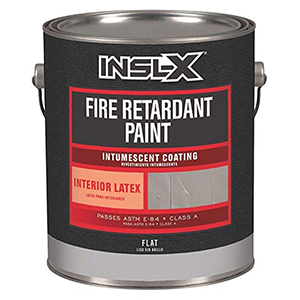Fire resistant paint
Fire resistant paint and what you need to know about it
Table of Contents
Fire resistant paint, or other fireproof construction and lining materials, have been compulsory for years now in office buildings, entrance halls, public buildings, parking garages and governmental buildings. In Canada the general rule is: the higher the building, the longer the material needs to resist fire. In case of fire, an appropriate fire resistant paint guarantees extended evacuation time, as well as vital extra time for firefighters to arrive and minimise damage.
Fire resistant paint, in general, comes with the following advantages:
- Suitable for various substrates –防火涂料适用于木材、部件l, concrete, textile and plastics.
- Durable protection –lasts for decades and makes the surface impact resistant
- Decorative –if applied as a top coat, it is available in every RAL colour
- Fire protection up to 120 minutes –conforms to British, European and international standards
- Prefab is possible –fire protection coatings can be applied before or after construction
When applying a fire protection paint there are several important factors that will affect your choice: the building type determines the minimum fire protection time required of the fireproofing method (30, 60, 90, 120 minutes), and each different substrate will need a specific product and application method (fire resistant coating for wood is different to one for steel). Therefore, in this article we provide you with professional advice on what you need to know when choosing a fire protection paint.
Buy fire resistant paint online
INSL-X Fire Retardant Paint
INSL-X Fire Retardant Paint
- INSL-X Intumescent Coating
- Suitable for: Interior use on primed or previously painted metal, wood, drywall, cellulose tile, cured plaster, masonry
- Colour: White
- Finish: Flat
- Resin Type: Vinyl Acrylic
- Rating: Class A ASTM E-84 (NFPA 255) and S-102
Fire resistance – the most crucial property of fire rated paint
If you are considering applying fireproof coating, then the structure of the building is part of what defines the coating you need; what is the building going to be used for, and what is the building’s height? There are three factors that define whether the building requires 30, 60, 90 or 120 minutes of fire protection.
- Height –The higher the building, the stricter the requirements: a building higher than 5 metres must be at least 90 minutes fire proof. A building lower than 5 metres does not always have specified fire resistance, which is why you should always consult a specialist when considering fireproof coatings.
- Risk factor –In some cases the fire resistance must be 120 minutes regardless of the height and purpose of the building. This is true for industrial facilities and places with a heightened fire risk such as offshore structures and chemical processing plants. This is also true for archives, libraries, and museums where valuable information or goods are stored.
- Residential / non-residential building –Are there, or could there be people sleeping in the building? Buildings below 5 metres must be 60 minutes fireproof, and buildings between 5 and 13 metres require 90 minutes. If the building is higher than 13 metres, the requirement is 120 minutes of resistance to fire.
Note that these three factors are not affected by the substrate type; the same rules count for wood and steel. In general, the costs of fire resistant paint can be estimated by the amount of coating needed and the required fire resistance: the higher fire rating the coating must have, the greater the investment to purchase and apply it.
Fire rating for your structure
Always consult a specialist about fire protection coatings to make sure your building is appropriately protected and meets the set standards. Our experts are happy to help you receive a competitive proposal for the coating you need: just send us a message by clicking the “request a quote” button at the bottom of this article.
The following table gives you an indication of what to expect from the fire protection for your building type.
| REQUIRED FIRE RATING | HEIGHT OF BUILDING | EXAMPLE APPLICATIONS |
|---|---|---|
| Not specified or 30 minutes | Non-residential buildings below 5 metres | Offices, shops, and company facilities |
| 60 minutes | Residential buildings below 5 metres | Hotels, apartments, and health care centres |
| 90 minutes | Residential buildings below 13 metres and non-residential buildings above 13 metres | Schools, hotels, blocks of flats, and prisons |
| 120 minutes | Residential buildings above 13 metres and buildings with high risk factor | Schools, hospitals, and blocks of flats; libraries, archives and industrial premises |
Fire resistance testing & standards in Canada
在加拿大耐火classifications, testing and standards of many institutions. The two most important bodies regarding classification and testing are Underwriters’ Laboratories Inc. and National Fire Protection Administration (NFPA). Knowing the following three testing and classification methods helps you define the coating that meets the specific requirements that apply to your building in Canada.
- Flame spreadrating –耐火材料l serve as a barrier between the flames and the combustible material, the rate of flame spread indicates to which extent the paint accomplishes the task. The rating is derived from comparing the flame spreading on the surface with the known rates of red oak (flame spread rating 100) and asbestos cement board (flame spread rating 0).
- Material testing –Fire resistance materials are subject to testing by many bodies; one to consider is Underwriters’ Laboratories. Their tests are based on “Fire Hazard of Building Materials” according toCAN/ULC S-102.
- Life safety code 101 –most Canadian building codes rely on the recommendation according to NFPA which system features five divisions from class A to E as presented in the following table.
| Fire resistance classification | Flame spread rating | 抵抗暴露于火 |
|---|---|---|
| 一堂课s A | 0 – 25 | Excellent |
| 一堂课s B | 26 – 75 | Moderate |
| 一堂课s C | 76 – 200 | Light |
| 一堂课s D | 201 – 500 | None |
| 一堂课s E | 500 + | None |
Fire rated paint specialists and certification
We advise you to leave the application of fire resistant paint to a certified contractor. Every building has specific requirements for fire resistance, and it takes a trained professional to apply the coating effectively.The building type, substrate type, and end use requirements all impact the choice of coating and the way it is applied, including such factors as film thickness. An inspection report needs to be drawn up by the contractor, including calculations for film thickness and the suitable materials for the project.
Once the coating has been applied, you will receive a certificate. This certificate confirms that you have complied with all relevant regulations and used the correct fire resistant coating. The coating must also be regularly inspected in order to detect any signs of premature deterioration and need for maintenance.
The two types of fire rated paint
There are two types of fire proof paint, intumescent and fire retardant, and each has a different method of impeding fire. They can be applied either independently or as a fire protective system.

A fire resistant paint system first prevents flames from coming close and then insulates the substrate from the heat.
- Intumescent coatings –almost predominantly applied as undercoats. This type of fireproof paint swells when the temperature reaches 200°C forming a solid foam-like char layer whichinsulates the substrate. Not only does it protect the substrate from ignition but also from the effects of the heat; steel loses its capacity to carry heavy loads starting at 300°C (572 °F).
- Fire retardant coatings –used as undercoats for regular paint or topcoats for intumescent coating. These coatingsrelease a flame damping gaswhen the temperature rises to extremes. This forms a buffer zone, protecting the surface from the flames. This is the most common type of fireproof paint used as an independent coating for wood.
When these two coatings are applied as a complete system, the fire retardant topcoat keeps flames at distance from the surface, postponing the swelling reaction of the intumescent undercoat. Once the fire has exhausted the topcoat, the undercoat kicks in. This system provides necessary extra time to get a fire under control.
Fire resistant coating specialists in Canada
Depending on the substrate material, there are several fire proof paint specialists in Canada whose services are available to you. Which one you should contact, depends on the substrate – most of them can help you with coating steel, but wood and concrete require different expertise. We at Coating.ca are happy to help you find the right specialist for your building, and provide you with a competitive quote. Just use our 100% free quote service by clicking the “Request a quote” button at the bottom of this article. Our coating experts are here to help. We also provide lists of intumescent coating application services inVancouver,888亚博VIP andOttawa.
Here is a selection of Canadian specialists in fire rated paints. These companies often use internationally recognised products from manufacturers such as AkzoNobel, Sika, Jotun and PPG.
| Fire resistant paint specialist | Address | Specialization |
| Contego | 9-75 Chambers Dr. Ajax, ON L1Z 1E1 | Application of industrial, commercial and consumer fire rated paints |
| Can Tech Global Distribution Inc. | “PO Box 684 Westfield, IN 46074” | Application of industrial, commercial and consumer fire rated paints |
| Can Tech Global Distribution Inc. | 830 Harrington Court #2, Burlington, ON L7N 3N4 | Manufacture and application of industrial, commercial and consumer fire rated paints |



